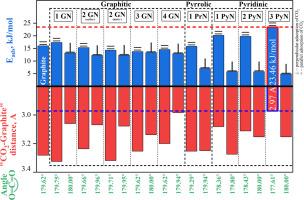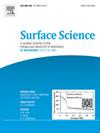Adsorption of CO2 on N-doped carbon materials: the effect of the subsurface layer
IF 1.8
4区 化学
Q3 CHEMISTRY, PHYSICAL
引用次数: 0
Abstract
In this work, density functional theory (DFT) was employed to study CO2 adsorption on graphite sheets with different types of nitrogen-containing adsorption sites: graphitic-N, pyrrolic-N, pyridinic-N. A periodic graphite model consisting of two layers was used in this study, and many-body dispersion (MBD) corrections were utilized to accurately account for the interactions between the graphite layers and the CO2 molecule. For the first time, the effect of the subsurface graphite layer on the CO2 adsorption properties of nitrogen-doped carbon materials was investigated. It was shown that the substitution of carbon atoms with nitrogen results in a redistribution of the electron density between the surface and the subsurface layer, especially in the presence of a carbon vacancy. The electron density redistribution on the graphite surface has a significant impact on CO2 adsorption energy, the distance between the surface and the adsorbate molecule, and the geometry of CO2 during its interaction with the graphite layer. CO2 adsorption energy was found to increase in comparison to that on pristine graphite in the case of carbon materials containing one graphitic-N site or pyridinic-N sites with a varying (1–3) number of nitrogen atoms, allowing the regulation of adsorption properties.

n掺杂碳材料对CO2的吸附:次表层的影响
本文采用密度泛函理论(DFT)研究了石墨片上不同含氮位点(石墨- n、吡咯- n、吡啶- n)对CO2的吸附。本研究采用了一个由两层组成的周期石墨模型,并利用多体色散(MBD)修正准确地解释了石墨层与CO2分子之间的相互作用。首次研究了亚表面石墨层对氮掺杂碳材料CO2吸附性能的影响。结果表明,氮原子取代碳原子会导致表面和亚表面层之间电子密度的重新分布,特别是在存在碳空位的情况下。石墨表面的电子密度重分布对CO2吸附能、表面与吸附物分子的距离以及CO2与石墨层相互作用时的几何形状有显著影响。与原始石墨相比,在含有一个石墨- n位点或含有不同(1-3)个氮原子数量的吡啶- n位点的碳材料中,二氧化碳吸附能增加,从而可以调节吸附性能。
本文章由计算机程序翻译,如有差异,请以英文原文为准。
求助全文
约1分钟内获得全文
求助全文
来源期刊

Surface Science
化学-物理:凝聚态物理
CiteScore
3.30
自引率
5.30%
发文量
137
审稿时长
25 days
期刊介绍:
Surface Science is devoted to elucidating the fundamental aspects of chemistry and physics occurring at a wide range of surfaces and interfaces and to disseminating this knowledge fast. The journal welcomes a broad spectrum of topics, including but not limited to:
• model systems (e.g. in Ultra High Vacuum) under well-controlled reactive conditions
• nanoscale science and engineering, including manipulation of matter at the atomic/molecular scale and assembly phenomena
• reactivity of surfaces as related to various applied areas including heterogeneous catalysis, chemistry at electrified interfaces, and semiconductors functionalization
• phenomena at interfaces relevant to energy storage and conversion, and fuels production and utilization
• surface reactivity for environmental protection and pollution remediation
• interactions at surfaces of soft matter, including polymers and biomaterials.
Both experimental and theoretical work, including modeling, is within the scope of the journal. Work published in Surface Science reaches a wide readership, from chemistry and physics to biology and materials science and engineering, providing an excellent forum for cross-fertilization of ideas and broad dissemination of scientific discoveries.
 求助内容:
求助内容: 应助结果提醒方式:
应助结果提醒方式:


